
Figure 1.
Distribution of 476 pupils for one day's practice before and after the records had been corrected.
Originally published in Psychological Monographs, 16(3), (Whole No. 69), 67-103, 1914
Franklin Orion Smith
Method of procedure
Effect of instruction
Effect of practice
Factors in the development of pitch discrimination
The physiological limit
Correlations
General conclusions
The present investigation forms a part of a series of researches in the Iowa laboratory[1] upon the tonal hearing. The problem was to determine the effects of training in tonal hearing, considering age, sex, musical education, general intelligence, and kinship. The investigation consisted of a preliminary training series, a ten days' practice series and the correlation of the results with those of other researches. The experiments were conducted in the University and in the public schools of Iowa City and Cedar Rapids in 1908-1912.
The tuning forks and accessories which were employed in this research are fully described by Professor Seashore in his report for the American Psychological Association on the standardizing of pitch discrimination tests. (Psychological Monographs No. 53.) The experimental precautions, both subjective and objective, were observed as set forth in that report. The only change made in the apparatus consisted in using two resonators instead of one, which is a decided improvement because one resonator alone does not speak sufficiently well at the extremes where increments as large as 23 or 30 v.d. are used. The methods of procedure recommended in the above named report were followed, as described on pages 39-43 of that report. The "heterogeneous" method was used in all preliminary experiments and with unclassified groups. This consists in presenting the increments 30, 23, 17, 12, 8, 5, 3, 2, 1, and .5 v.d. in the order named a number of times and finding at what level in that series the threshold falls in from ten to twenty trials. The mean variation of the records for all such sets is then computed by the method described on page 42 of the above named report, as follows:
For ordinary work we therefore recommend as a measure of variation in the record the use of the mean variation (m.v.) computed as follows: Regard the difference between successive steps as equal psycho-physic steps and, with the increment which is nearest to the median as a base, multiply the number of cases which are one step from this base by 1, the number that are two steps away by 2, the number that are three steps away by 3, etc.: divide the sum of these products by the total number of cases (sets).
The homogeneous method is the ordinary method of right and wrong cases or constant stimuli, counting the threshold at 75 per cent, correct cases. This method was used in dealing with individuals or groups formed on the basis of preliminary tests.
The preliminary training consisted of two tests which are designated as the first and second preliminary tests respectively. The observers consisted of pupils in the elementary and high schools, and students in the University. The ages vary from nine years to maturity. Most of the observers were unmusical in the sense that they had received no special training in music. These tests were made in the schoolrooms under good conditions. The temperature and ventilation were regulated by automatic systems (except in two small grade schools). The regular teacher remained in the room during the experiment maintaining normal conditions of order and school spirit. These general conditions did not differ materially among the schools nor among the different rooms of the same school. The tests were carried on in the morning between nine and twelve o'clock, each test lasting twenty to twenty-five minutes.
Since it was not practicable in all cases to employ the homogeneous method, all the group tests were made by the heterogeneous method. In figuring the results the nearest whole vibration (except 0.5 v.d.) was taken. The increments in the series of tones used (0.5, 1, 2, 3, 5, 8, 12, 17, 23 and 30 v.d.) are referred to as units and are considered equally difficult to distinguish. That is, 23 to 30 v.d. is assumed to be as difficult for one whose threshold is 23 v.d. as 1 to 2 v.d. is for one whose threshold is 1 v.d.
In case of defective hearing the pupil was seated where he would be certain to hear; or, if the deafness was serious, he was excused from the test. The rhythm of the work period was not so easily controlled. The tests were comparatively short and every effort was made both by the experimenter and the attending teacher to keep the effort up at a high pitch throughout the test. Indifference is perhaps the largest source of error in the few cases where it was manifest. This could be recognized directly at the time of the test and usually also by the distribution of errors in the records.
One of the most striking and yet perplexing facts about pitch discrimination is that there is often no relation between the feeling of certainty and the correctness of the judgment. The judgment is often based upon a clear illusion. This illusion of hearing in the case of wrong judgment aids much in the encouragement to sustained effort.
Anticipatory judging is a fruitful source of errors. Under the influence of expectant attention the observer anticipates the second tone the moment he hears the first. The experience is analogous to the illusion of lifted weights. With a strong expectation of hearing the second tone high, or low, the organism is set to make the appropriate response and this has marked influence upon the judgment. Closely related to anticipatory judging is the tendency to compare the present tone with the preceding pair. In fact this tendency often leads to anticipatory judging especially when the first tone of the present pair is compared immediately with the last tone of the preceding pair.
The confusion of pitch and intensity is a troublesome source of error, particularly with unpracticed observers. Making the tones actually objectively equal in intensity does not always allay the difficulty as disturbing associations may tend to create confusion. High tones are intrinsically louder than low tones. A slight difference in intensity is often interpreted as a difference in pitch.
In computing the characteristic figure of a record it is necessary to take account of internal evidences and make a "correction" as is explained in the report of this test referred to above, pages 45-48. This must always be a matter of "good judgment" and can not be done mechanically. Certain factors may however be quite clear and' exact. The distribution of the records in the heterogeneous test with respect to the operation of the laws of chance is one of the most telling. A record of, e.g., 8 v.d. may on examination of the distribution of the errors be found to contain indisputable proof of a threshold of 2, or 1, or .5 v.d. as the case may be.
Sometimes when a source of error has been noted a study of the distribution may show where it operated and where it did not operate. A small mean variation, e.g., 1.0 or less is almost certain proof of the reliability of the actually computed median. The study of the internal evidences therefore has its principal use in cases showing a large mean variation. All our records were examined with reference to internal evidence of error in the computed median and, it must be frankly admitted, wherever such evidence was found the correction was made. All the records here used in the heterogeneous method are therefore "corrected" records. Figure 1 shows, it will be seen, that the tendency of the correction is to lower the record and that most of the corrections are made for those who have poor records.

Figure 1.
Distribution of 476 pupils for one day's practice before and after the records
had been corrected.
As a preliminary to the training series two tests of about 25 minutes each were given to 1980 pupils by the heterogeneous method in their regular class divisions. In the first period the test was begun without any explanation beyond what was necessary to direct them about reporting "higher" or "lower". The second period was opened with simple and diversified explanations and illustrations of what pitch is. This explanation was based upon a previous study of the kinds of difficulties encountered. Pitch was differentiated from intensity, duration, volume, timbre, etc. in familiar talk and by different instruments.
Unfortunately the two factors of instruction and experience, or direct observation resulting in a growing familiarity with the problem, are not isolated. We have simply the records for the two periods and must interpret the gain as due to both of these factors, which are, of course, inseparably associated. To facilitate comparison the observers were divided on the basis of these tests, into A, B, and C grades in accordance with the possession of a good, medium, or poor ear. Grade A includes those who hear differences of less than 3 v.d.; grade B those who hear differences of 3 to 14 v.d.; and grade C those who hear differences of 14 to 30 v.d. or above.
Table I.
Distribution of those who improved in the preliminary test.

Italics designate increments; the other figures give the number of cases for each of the respective degrees of improvement; thus, of those who had a record of 30+ in the first test, 11 went to 30-, 11 to 23, 10 to 17, 15 to 20, 6 to 8, 3 to 5, 2 to 3, and to 2 in the second test. A shows the total number of cases at each increment in the first test; B same in the second test.
The records show that 54 percent made no improvement in the second test; 46 percent of all observers made better records in the second preliminary test than in the first. The amount gained varies from 1 to 8 units. The average amount gained varies from 3.8 v.d. at nine years of age to 0.3 v.d. at maturity.
Table I analyzes the distribution and the amount of gain by the cases (46 percent) which improved with the instruction. Of the 46 per cent, who improved, only 7 percent changed from grade C to grade A in the second test. Of the 425 pupils (22 percent) who improved and were in grade B at the beginning, 255 (60 percent) changed to grade A in the second test. Measured by the first test 26.5 per cent, of those who improved were in grade A. Measured by the second test 70 percent were in grade A. Of the changes to grade A, 96 per cent, were from grade B; and 91 percent of the changes to grade B were from grade C.

Figure 2.
The effect of instruction. Distribution of 907 pupils who made improvement from
the first to the second preliminary test.
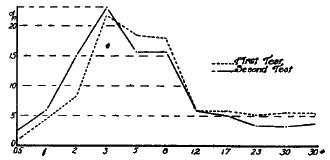
Figure 3.
Distribution of entire group, 1980 cases, in preliminary tests.
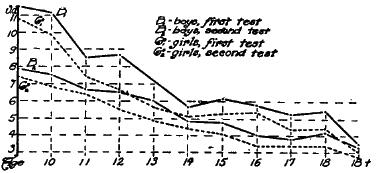
Figure 4.
Distribution of improvement in the preliminary tests by age and sex, 417 boys
and 490 girls.
The effect of the instruction and experience thus gained from the first to the second test is shown in Figure 2 which represents only the 46 percent of cases in which improvement was made. Figure 3 shows the effect upon the whole group of 1980 cases. Figure 4 shows the distribution of improvement by age and sex.
TABLE II.
Distribution of forty-seven out of fifty-four university students who improved
with individual instruction.

Notation and plan of this table same as in Table I.
A similar test of the effect of instruction was made in a class of 200 adults. After two preliminary tests, one heterogeneous and one homogeneous, the poorest one-fourth of the group were taken and instructed individually as to the actual nature of pitch hearing. An effort was made to find out what particular difficulties they were encountering, and explanation and illustration were based progressively upon this information. As a class these had made but little improvement in the second preliminary test, both the first and the second having been given "without instruction". But as a result of this personal instruction all but 7, i.e. 47 out of the 54 made rapid improvement. The change in the record for the group is shown in Figure 5 by giving the distribution at the beginning and at the end of the period of individual instruction. The distribution of the gain is analyzed in Table II.
The fact that these were adults familiar with the class room and trained in many psychological experiments, yet made such marked response to the instruction and individual help, doubly emphasizes the importance of thoroughness and individual attention in the instructions if the records are to be entirely reliable.

Figure 5.
Distribution of 54 university students in individual tests (Table II).
One of the best experimental proofs that we have showing the efficacy of individual care and instruction is found in the unpublished experiments of Dr. H. S. Buffum, which have been summarized in the above mentioned Psychological Association report by Professor Seashore, as follows:
Dr. Buffum experimented on twenty-five eighth grade pupils in a grammar school room. He first made a fifteen minute individual test of each pupil and classified them on this basis into three groups with modes at 3, 8, and 17 v.d. respectively. The object was twofold: (1) to determine the effect of practice and (2) to determine the success of the preliminary examination. For this purpose he gave them twenty forty-five-minute periods of training.
The results show (1) that for no group is there any evidence of improvement with this practice, and (2) that all except two children remained throughout the whole practice series within the group to which they had been assigned. Of these two, one who had been assigned to group III was immediately found to belong to group I as there had been a failure to understand the preliminary test; and the other, although retained in group II, proved really to be near the dividing line and could have been classified in group III. Evidently the physiological threshold had been reached in twenty-four of the twenty-five cases in the preliminary test."
In Dr. Buffum's experiment the fifteen-minute preliminary classification, was so efficient as practically to eliminate poor records due to ignorance of the test.
The significance of instruction is further proved by the records in successive classes in the university for a period of years. It is found that the average record has improved slightly from year to year. There is no reason for believing that this is due to anything but improved skill and technique and increased care in the instructions and charge to those about to be examined.
In the above records we have conclusive evidence that effective instruction is of the greatest importance in making records on pitch discrimination. It is not a poor ear, but ignorance that accounts for the bulk of poor records in a first test. Those who made a fine record in the first test are, of course, not subject to this source of error; and those who have poor records but show no improvement after instruction or prolonged training may also be free from this source of error. It is a safe rule to say that all tests should be preceded by efficient instruction; if this can be made individual, so much the better; and all who show poor records must be subjected to more intensive and searching instruction before the record can be accepted for serious purposes.
The first of the two extensive experiments in practice was a series of group tests by the "heterogeneous" method covering a period of ten days. The second was a series of individual tests on adults by the "homogeneous" method. In addition to these certain special training series will be described.
The group tests were made on 476 pupils (215 boys and 261 girls) in two elementary schools selected from those in which the preliminary tests had been made. These practice tests were conducted in the same manner and under the same conditions as the preliminary tests except with regard to instruction. Each test was preceded by a brief warming-up exercise in which the pupils answered orally. This also helped to keep interest alive. A short rest period was taken at the middle of each test. At this time opportunity was given the pupils to ask questions about the test.
Running parallel with the class tests were certain individual tests which were carried on in the afternoon following a given set of class tests. At the noon intermission the records of one or two grades were checked up and pupils whose threshold for that day was between 20 v.d. and 30 v.d. were given individual practice. The object of these individual tests was to give special assistance to backward pupils, aiding them to distinguish different tone qualities and to form right habits of attention. These tests include 71 boys and 35 girls constituting the poorest in the group tests.
With regard to the general musical preparation of these pupils it may be said that music was taught systematically in all the grades, and that the schools were provided with Victor graphophones in which high grade selections were played regularly. For comparison the cases under observation may be divided as follows: Group I, those who made no improvement either with instruction or practice; Group II, those who made no improvement in the practice; Group III, those who made little (1-3 v.d.) improvement in the practice; and Group IV, those who made marked improvement (3 v.d. +).
The records of these practice series on children are set forth in Tables III-IX and Figs. 6-10. Table III gives the daily average threshold for the twelve days of training by ages, section A showing those who do not improve with training and B those who do improve with training. Table IV gives the daily average threshold for those who improve with training regardless of age for the four groups. Table V gives the averages of the same separately for the boys and girls, Groups II, III, and IV combined. Table VI gives an analysis of the distribution of those who improve with practice. Table VII (Figure 9) contains the record of those who were given individual tests or help during the practice, showing the daily record and the record of two individual tests in the average for the group. Table VIII gives a comparison of the mean variations with reference to sex and age. Table IX gives the distribution of those who attain the approximate physiological threshold in different days of the practice.

Figure 6.
Daily average, by groups, of those in the practice series (Table VI).
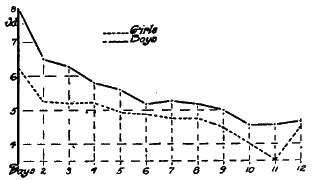
Figure 7.
Daily average by sex (Table V).

Figure 8.
Distribution of 270 pupils who improved with practice (Table VI).
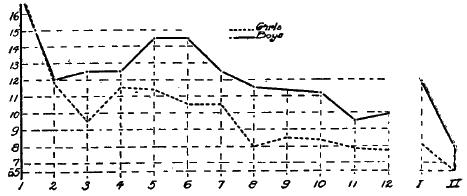
Figure 9.
Daily average record of those who were given special individual help (Table
VII).
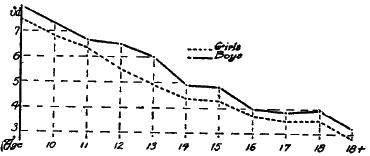
Figure 10.
Comparison by ages of the average (median) abilities of boys and girls.
TABLE III.
Daily average threshold, by age.
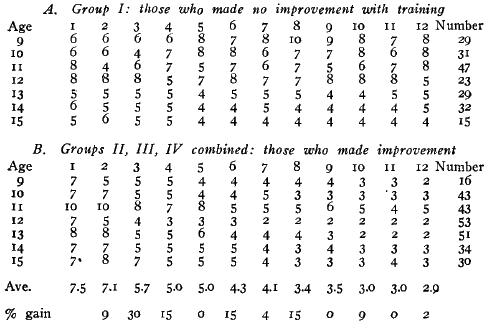
TABLE IV.
Daily average by groups.

TABLE V. (Figure 7)
Daily average by sex for for Groups II, III, and IV.
![]()
TABLE VI.
Distribution of those who improve with practice.
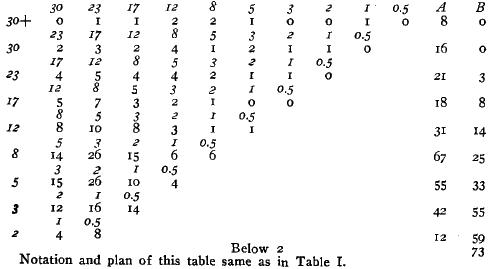
TABLE VII.
Daily average record of those who were given special individual help.

TABLE VIII.
Average mean variation from the individual records in the preliminary and final
tests.

TABLE IX.
Distribution of those who reach the approximate physiological threshold on
different days of practice.
![]()
Of the 476 children 206 (43%) fall in Group I; i.e., so far as the instruction and practice are concerned, these made no improvement that could be traced in the records, due allowance being made for daily variable errors. The number of those who do not improve with practice is relatively greater for the younger than for the older children.
Classifying these 206 on the basis of record into Grade A, those whose threshold is 4 v.d. or less; Grade B, those whose threshold is between 4 v.d. and 14 v.d.; and Grade C, those whose threshold lies above 14 v.d., we find 40 percent in Grade A, 51 per cent, in Grade B, and 9 per cent in Grade C. Of the 270 cases (57 percent) which show improvement with practice 19 percent are in Grade A, 64 per cent, in Grade B and 17 per cent, in Grade C.
Relatively the largest number of cases of improvement occur among those who start out with a very inferior record. This can be shown by comparing the distribution of cases which make improvement for each of the increments as set out in Column A, Table VI with the normal distribution of thresholds for the entire group.
Of those who did not improve ten were unable to hear any of the increments used and judge as required. It was however found upon making private examination of the seven of these who were available that they could hear tone differences, Two of these could distinguish between A and B on the piano. Two of them seemed unable to grasp the concepts "high" and "low" with reference to the naming of pitch. One of these-- a scatter-brain-- could, however, sing a half-tone correctly when played on the piano. The other-- retarded about five years-- could sing a fifth fairly accurately with the piano. Three were able to imitate a pitch difference in the forks of 3 v,d. by singing enough to show whether the second of the two tones was sharp or flat. The other three were, unfortunately, not available for special tests. Thus, of the 476 cases not a single case of so-called tone deafness was found.
The last line in the footings of Table III, B shows that the gain of those who do improve is most rapid in the first part of the training series, 54 percent of the gain being made in the first three steps. The further analysis of these figures in Table IV, illustrated by Figure 6, shows that this principle is true for all three of the groups which show improvement.
All the observers included in Table VII took the first individual test which occurred on different days, from the third to the seventh day. Most of these tests were given early in the practice series. The second test began on the fifth day and extended over the remainder of the practice series. Only 26 boys and 9 girls needed to take this test, A very few were given a third test near the end of the practice but the results were not included in the table. Not only does the individual test yield a lower median than the group test in a majority of cases, but the individual test often influences the later results of group practice. In this experiment 6 boys and 4 girls made immediate and permanent improvement after the first individual test which it will be remembered was accompanied by instruction, In one case the gain was from 30 to 9 v.d.; in another from 23 to 5 v,d, and in a third from 24 to 10 v.d. In some cases improvement did not begin until after the second test, and in the case of 29 boys and 13 girls no improvement was made. Of these only 2 (both girls) made better records in the individual tests.
The average amount of improvement for all cases at each increment decreases with the diminishing of the increment, This is seen in Table VI, and may also be seen graphically in Figure 8. It must be remembered that this figure does not represent the whole group but only those who improved.
The series is not long enough to guarantee that any or all reached the physiological threshold,[2] The main difficulty in determining this lies in the fact that persons often come to a "plateau" in the record which is due to some motive or condition which may be removed by instruction or training. This, however, gives trouble only when it continues to the end of the training series, Classifying the cases roughly on internal evidences of the records we find that what may be approximately the physiological limit is reached in successive days as set forth in Table IX. From the variations in the records it is quite clear that the data in this table are quite problematical. To get the actual physiological threshold it is necessary to have more favorable conditions for isolation of the observer and the elimination of disturbances. Undoubtedly there may also be several who remain on a "cognitive" plateau throughout this series and would improve under the proper impetus. Yet, due allowance being made for these sources of error, the table shows that there is a "rapid maturing" in this training; 6 per cent, reach their bed-rock level on the first day, 8 per cent, on the second, 9 per cent, on the third, etc.
After the preliminary tests the number who reach the approximate physiological threshold increases gradually to the fourth day. On the fifth day the number increases suddenly from 24 to 41 (9 per cent, to 15 percent) and then gradually decreases to the eighth day after which there is a rapid falling off to the tenth day. (Table IX). The results show that 47 percent of those who improve reach the approximate physiological threshold by the fifth day of practice.
The mean variation as given in Table VIII conveys three significant items-- the result of practice, the variations with age, and the variations with sex. It must be borne in mind that the unit of the m.v. is not the vibration but the increment, as was described above. That is, the increments increase in a geometric ratio of the second order; therefore, e.g., the increment 17-23 v.d. counts one unit just as do the increments 5-8 v.d. or 1-2 v.d. It follows that as the threshold is lowered the mean variation unit remains relatively constant. Equal power of application of those who have high and those who have low thresholds should therefore show in about equal mean variations; and, conversely, unreliability in judgment will show in increased mean variation equally for the one who has a fine ear and the one who has a poor ear.
The mean variation is slightly larger in the final training test than in the preliminary. The difference is not large-- only .04 units-- but it is fairly constant for all ages and for both sexes. This is rather remarkable as, in the nature of the test, one would look for evidences of increasing familiarity in the lowering of the mean variation. On the other hand the fact that the procedure does not reduce the mean variation is a most telling proof of the elemental nature of the test. The test is so stripped of conditions for variability that it is possible to be as consistent in the preliminary trial as in trials after practice.
The variability is a trifle larger for girls, both in the preliminary and the final tests. This is true for all the ages except 12 and 15 in the preliminary and 10 and 15 in the final, Were it not that this has a bearing on the much mooted question of sex difference on this point and that the data here given represent such a large number of cases (1980 in the preliminary and 476 in the final) no significance would be attached to this difference. The second decimal figure is of doubtful value in an average of this kind and, as stated, the variation is in one direction for five ages and in the opposite for two both in the preliminary and the final. On the whole our interpretation is, therefore, that practically there is no significant difference in the variability of the boys and the girls in pitch discrimination.
There is a general, though not great, tendency for the mean variation to decrease with age. This is the measure of growing reliability with age which we are accustomed to find in records of this kind.
In this practice series in the elementary schools there are two items that count distinctly in favor of the girls. One is that of the 215 boys and 261 girls who took the practice series, 71 boys and 35 girls were considered, on the same basis, poor enough to need individual instruction and drill. This is a distinct mark of superiority in the girls. The other is that the girls in the training series, quite uniformly for all ages, have a lower threshold than the boys by from one to two vibrations. (See Table V and Figure 7).
This superiority of the girls over the boys is evidenced also in the preliminary tests with remarkable uniformity as is seen in Figure 10 where a fairly constant difference is maintained throughout all the ages. The same fact is illustrated from another point of view for the elementary school in Table X and Figure 11. This difference, however, disappears when we come to the higher ages. Figure 12, for the high school, and Figure 13 for the university, based on Table X reveal no recognizable superiority of either sex in the preliminary tests.

Figures 11, 12, 13.
Variation with sex and age. Based on preliminary tests in the elementary
schools.
A comparison of pitch discrimination for different ages in the preliminary tests is given in Table X. This shows that the order of superiority is: university students, high school pupils, and elementary pupils, the respective modes being roughly 2, 3, and 4 v,d. This comparison is however not quite fair, inasmuch as longer tests were given to the university students than to the high school pupils and longer to the high school pupils than to the elementary pupils; and the longer the test the more favorable the results tend to be. As will be shown later, this, together with the better control of experimental condition among the older pupils, may be ample to account for the differences here shown, so that, under equally good conditions of testing, there would probably be no evidence of variation with age.
In Table XI we see that at the age 9 the cases are about equally distributed in the three grades. Grade B remains about constant for all ages; but the number of cases in Grade A decreases with age as the number of cases in Grade C increases. Figure 14 shows a comparison for age only.

Figure 14.
Comparison of threshold of pitch discrimination for different ages.
TABLE X (Figure 11, 12, 13 and 14).
Variation with age and sex (Preliminary tests).
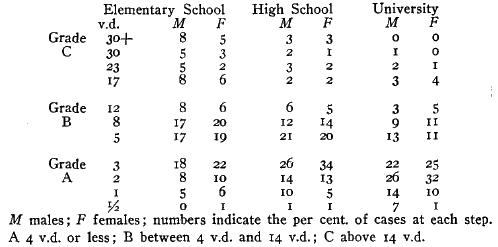
TABLE XI.
Distribution by age and group in terms of percent of cases.

The comparison of the mean variation for the three groups of ages given in Figure 15 shows that the reliability of the records of the high school pupils is practically as good as that of university students. Elementary pupils are slightly inferior but not so much as we would ordinarily find in other tests of discrimination.
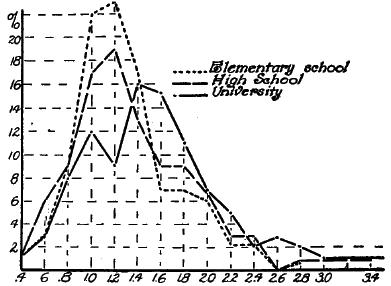
Figure 15.
Comparison of mean variation (m,v.) in the preliminary tests for different ages.
Some records of practice in pitch discrimination have been collected incidentally in this laboratory. The case of C.E.S. is presented (Figure i6) to illustrate how variable the threshold may be aside from practice. The first practice series of twenty half-hour periods was taken in 1898 with crude methods. No resonator was used, the forks being held to the ear. This, perhaps, introduces the largest source of error in that series. Unfortunately data are not available for determining other causes of the inferiority of this record. Beginning with 1906 the Koenig resonators were used with a good quality of forks. The fact that, from this point on, the record is fairly constant would seem to indicate that the absence of the resonator in the foregoing series was the chief source of error. In 1907 the experimenter was not skilled. In 1910 the tests were made for the purpose of comparing certain conditions of environment, such as the light and sound-proof room, a class room, and out in the open air. From the 43rd to the 48th day a study was made of the effect of the duration of the tone and the time interval between the two tones. On the last four days distractions were introduced, The best record was made while the observer was intentionally tracing a maze.
Something was wrong in 1898. M. C. W. (Figure 17) made a poor record in the twenty period practice undertaken by the same method and means as in the case of C. E. S. above. In 1908, as soon as the good resonator was introduced, her record was fine and free from fluctuations. She had, however, learned to play the violin and had gained experience in the tuning of forks in the years that elapsed since 1898. Her best records were made with distractions-- tracing a maze or crocheting. These records furnish most striking evidence of the importance of reliable apparatus and technique.
In Figure 18, characteristic results of practice, under most favorable conditions of control are shown; a, b, c, and d are the respective practice curves for four graduate students practicing one hour daily, sixteen days.

Figure 16.
Record of C. E. S.

Figure 17.
Record of M. C. W.
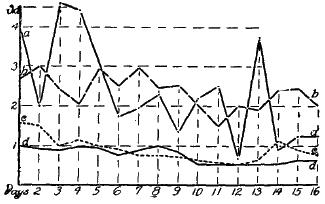
Figure 18.
The effect of training.
Practice in pitch discrimination means (1) the control of a special set of cognitive factors involved in learning to recognize differences in pitch, and (2) the acquisition of skill in listening to musical tones. In most of the recent experiments on practice, such as those made by Book on typewriting, Swift on tossing balls, Bryan and Harter on telegraphy, Judd and others on handwriting, and Huey on reading, the object has been to determine the mode of acquisition of certain special habits. Of these Book distinguishes two sorts, habits of manipulation and habits of control: The latter he defines as certain general or more purely psychic habits acquired in the course of practice. It is to this type of learning that the present analysis is directed. Of these general habits or modes of control we may distinguish three types, (1) sensory control, by which is meant acquaintance with certain sensational facts, such as auditory qualities of the tones, and muscular sensations; (2) associational control, or acquaintance with memory images, as auditory, visual, and motor; and (3) control of special attitudes, as feeling of familiarity, most favorable form of attention, interest, etc.
Auditory and kinaesthetic sensations seem to play the leading role in judging differences in pitch. Two types of observers may be distinguished. First, there are those whose perception of pitch is chiefly in terms of tonal qualities. They learn to direct attention to the characteristic sharpness or fineness of the high tones and to the flatness or dullness of the low tones. The particular sensory quality of the tone varies with different persons. One notices that the high tone is sharper, and has a tendency to last longer in the ear than the low tone. Another describes the high tone as finer and more piercing. The lower tone is usually distinguished from the higher as being duller, deeper, heavier, and more mellow. It is also interesting to note that some observers judge altogether by the high tone, while others judge only by the low tone. Some persons seem to have an affective preference for high tones, others for low tones. This forms an apperceptive basis for the judgment.
Second, there is a considerable number who depend largely upon kinaesthetic sensations of the vocal organs in making the judgment, Regarding these Stumpf says: "If the muscular sense in the vocal organs is the same as a former tone that we have heard, we judge that it is the same tone. If we are told that a certain tone is A, we remember that a tone giving the same sensations is A. If the muscular sense changes in a definite way when we sing two tones, we say that the tones rise. If a distance is noticeable in the change, we judge the second interval to be greater." Stricker did not think of music in terms of notes nor of auditory images, but in terms of muscular sensations in the vocal cords. He speaks of the impossibility of the reproduction of a tone in the memory without bringing into play the actual or intended use of the vocal organs. He considers the connection between tone perception and the innervation of the vocal organs a sort of reflex.
This view is in accord with many introspections in the present investigation. Some of the observers allege that they are not able to tell whether the second tone is higher or lower until they reproduce the tones either audibly or mentally in terms of vocal strain. In one individual test the observer, a university student, was not able to distinguish a smaller difference than 20 v.d. by merely listening to the tones. When he was told to hum the tones, he immediately ran down to 8 v.d. and continued to improve, reaching 2 v.d. Singing seems to enhance the power of discrimination partly on account of the timbre of the voice and partly on account of the motor elements in vocalization. "I carry the first tone over and when I hear the second I hum it to see whether I feel more or less strain in the vocal cords."
These muscular and kinaesthetic sensations are not always confined to the vocal cords. They may start in the vocal cords and spread to other organs; as, for example, "A strain starts in the vocal cords and runs up through my head." The sensations may be initiated in other organs, or they may be felt as general bodily changes. "I feel the tone as a singing in my head." "In case of the high tone, the singing is 'stronger' than in the case of the low." "The high tone seems to make a stronger impression in my ears than the low tone." By impression the observer probably means muscular strain. "I feel the tones as vibrations in the body. They seem to go all through me and cause a sort of strain." "I have a tendency to breathe more deeply for the low tones." "The high tones give me a sense of elation; I seem to mount. The low tones seem to give me an experience of gentle relaxation, a general feeling of calm." "I have a distinct tendency to move up and down according as the second tone is high or low." "Low tones seem to drag me down; high tones seem to lift me up." "I feel an upward impulse and tend to rise with the high tone." "The mind seems to be a little more tense for high than for low tones." The affective quality of the tone is often the important element in consciousness. "When the low tone follows the high tone it seems to be more pleasing." "The high tones feel different but I can not explain the difference."
In most instances the auditory and kinaesthetic sensations combine into an auditory-vocal perception. Thus the judgment is a highly complex process conditioned by a mass of auditory and muscular sensations. The total result in consciousness, however, is a simple experience, a mark of familiarity which enables the observer to interpret the difference immediately.
In addition to sensory processes the judgment is conditioned by certain associational processes, chiefly auditory and visual images together with certain associations which are built up around these.
Many speak of carrying over the memory of the first tone and comparing the second tone with it through auditory imagery. The clearness of the image, and hence the certainty of the judgment, depends upon whether the interval is short or long. This varies somewhat with different individuals as does also the character of the imagery. Some observers associate certain familiar tones with the image of the present tone. The low tone sounds like the "hoot of an owl." The high tone is associated with the major key and the low with the minor key, or perhaps the observer imagines he hears his own voice singing the tones.
Visual imagery includes localization in space, voluminousness, and color-tone qualities. "The high tone seems to glide up at the end." "High tones seem nearer and low tones farther away." "I have a visual image of a teeter board," "High tones seem to be in the upper part of my head; low tones in the lower part." "I think of ti, do, or do, ti in the musical scale." This observer was unable to describe the tones in terms of auditory imagery. "The high tone appears to be higher up in space than the low." This reply is typical of a large number and seems to play an important role in the perception of difference. "The high tone has a swelling, expansive feel in the left ear and seems to have a pull upwards-- a lifting quality-- almost to the point of unpleasantness in strength. The lower tone seems to be located in the right of the direction of the head and below. The high tone is nearer the head, the low tone far away."
In the following case the method of localization is unique. The relative
position of the two tones is the reverse of what is usually found. "The low tone
appears to be above the high in space. It is also larger so that the two tones
would be represented by a heavy above a light line, thus:
![]() ."
."
Many observers refer the tones to a musical scale or musical instrument. M.O. thinks how she would play the violin to produce the different tones. H. S. sees her finger move up and down the violin string. O. S. says, "When I think of the second tone as higher I think of it as higher up on the piano." Another says, "I seem to see my fingers moving along the violin string."
M. C. W., a trained psychologist, locates the tone by a peculiar kinaesthetic-visual imagery. The high tones go up to the right and lie in the head, the low tones move down to the left and lie near the left side of the root of the tongue. The first sound is in the aural axis, a little to the right. All are thought of as in the head, though she knows the real source.
"High tones seem long and pointed while low tones seem big and fiat." M. describes the interval as a pyramid or cone with the high tone at the apex and the low at the base. For W. "High tones are fine and sharp. They seem thin and compact: I imagine an object contracting. Low tones are relatively rich."
Colored hearing plays an important part in the judgment of some observers. Moritz Katz (Zeitschr. f. angew. Psychol., 1911, pp. 1-53) has reported on color impressions of Schumann, Tieck, Liszt and others. In the present study the following are noted: "The high note seems to be a brighter color, the low darker." "High tones are bright and clear; low tones are dark and murky." M. always thinks of sounds in terms of color. Her impressions are remarkably complex and varied. "When I hear sounds that please me they appear violet. When I am talking with any one whose voice is pleasing, I see violet color. When I listen to a soprano solo I see a section of the rainbow. As the tones become higher they change to bright green and the very highest tones appear like little flames of lire. Low tones are reddish brown. Any rasping or disagreeable sound appears red or brown. When I hear a chorus of mixed voices or an orchestra there seems to be a large mass of violet color and from this on all sides little short tongues of various shades of green, yellow, and red." She does not remember when she did not translate sounds in this way. L. M., 17 years old, combines spatial and brightness qualities with tones. A very high tone appears to be a bright vertical line. As the pitch is lowered the line grows in width, but diminishes in brightness.
As regards the most favorable form of attention we have two factors, the direction of attention and the level of attention. As regards the direction of attention three modes are possible. One may attend to the beginning, the middle or the end of the tone. More than half of all observers select the middle of the tone as the critical point. The rest are about equally divided between the beginning and end of the tone. Closely connected with these modes of reaction is the snap judgment. With the organism set for a definite point in the tone, the judgment is made the instant this point reaches the focus of consciousness. This form of judgment when once brought under control almost always favors improvement.
It is also observed that it is easier to judge which tone is higher or lower if the 'forks are presented abruptly. If the tone swells gradually from a faint beginning, it appears to raise the pitch slightly and thus confuses the judgment.
The most favorable level of attention varies with different individuals. The introspections show that for some the closest attention to the tones is required for successful work. Others say the very keenest attention causes high nervous strain which leads to mistakes. The writer has observed this very definitely in his own case. T. F. V. says, "Much depends upon my attitude. If I hold myself in a passive attitude and answer with ease, in a reflex way, I am quite sure to be correct in my judgment; but if I get the attitude of strict attention I cannot do so well. If I can keep in a state of relaxation, I experience no difficulty in giving the judgments." Practice usually results in what Professor Welton calls receptive recognition. When one becomes familiar with tones there ceases to be that active attitude of attention which characterizes the first few tests. The two tones are 'not thought of separately, but the interval is grasped as a whole and is interpreted by its total effect in consciousness, The factors which enter into the judgment do not come into consciousness, but remain unconscious. All that the observer can state is that he knows the instant he hears the second tone whether it is high or low. There is no consciousness of a memory image and no comparison.
To determine the effect of distraction three series of tests were made. In the first the eyes were closed (no visual or motor distraction) ; in the second the eyes were kept open and allowed free movement (normal distraction) ; and in the third the observer was required to trace a maze while performing the test (regulated distraction). The effect seems to be about equally distributed between helping and hindering. All but two were appreciably aided by distraction at the beginning of the series. At the close only two were especially aided and only one found distraction a hindrance. In all the other cases, when the distraction method became automatic, it ceased to influence the results. Moderate distraction seems to be an aid chiefly as a means of raising the level of non-voluntary attention. The best form of attention for a majority of observers seems to be a periodic fluctuation between sharp and instant attention to the tones and complete diversion during the interval between two pairs of tones. The problem of distraction is an exceedingly complicated one. Perhaps the most striking result of this series of tests was the demonstration that distraction enters even when we are most expected to concentrate upon a single task. Table XII shows the per cent, of right judgments with and without distraction.
TABLE XII.
The effect of distraction.
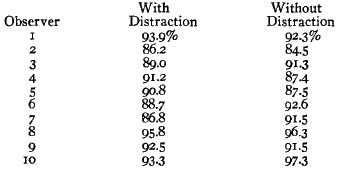
The following extracts from introspections illustrate the general mental attitude toward the different methods, These were written at the close of the series of tests and express the observer's impression at the time.
D. A. A. "In the beginning of the test I felt distinctly dissatisfied with surroundings and was annoyed by the peculiar effect the room had on the quality of the tone. This was overcome in about twenty minutes, The maze failed to arouse interest and hence was of no assistance-- quite the contrary, it was really an annoyance-- a distraetior~ unfavorable. During the time I took 100 with eyes closed I was able to inhibit any absorbing interest in anything except the discrimination of tones. I was able to concentrate very definitely on the work in hand. Following immediately with closed eyes on a test with 0.5 v.d. I grew tired of the uniform method (eyes closed) making two mistakes in the first 50 and six in the second 50. About five of the errors were attended by a feeling of decided uncertainty and the others were caused by some annoyance. Returning to the use of the maze for the last 100, 0.5 v,d. I voluntarily renewed interest in the affair and raised my record making but four errors in the 100 judgments."
J. E. B. "At first the maze troubled me, but after going over it a number of times I could do it rather automatically so that more and more attention was given to the tones. When the eyes were open there were always numerous disturbances that would effectively distract attention. With the eyes closed there was very little to distract attention."
M. C. "Working at too great tension seemed to be my greatest difficulty during the tests, especially with eyes closed and eyes opened. The maze seems to relieve that tension though I rather expected the opposite effect. As a result of the tension I found myself confused at times and made several errors in succession. I could not notice much difference in my own attitude toward the test with eyes closed and that with eyes open. Possibly there was a greater effort to center attention on the two sounds when my eyes were open. In both of these tests there were times when I seemed to notice a difference in pitch, but could not tell which sound was: higher. This difficulty seemed to disappear with the maze test."
N. E. G. "I felt that it was much easier to decide with my eyes closed than with the maze, However, my third record shows fewer errors with the: maze."
P. H. H. "In the test using the maze it seemed easier to concentrate the mind; that is, the mind was concerned with two definite things: the maze and the tones, as opposed to the free associations. There was less inclination to drift to other things. The decisions in the maze test involved less conscious effort and seem to be 'felt' rather than consciously formed. Errors in the maze test often followed the effort to locate the end of the pencil line, after it was lost through the recording of the introspection. I gained better success by starting the maze line ahead of the trial."
T. F. V. "I found in this experiment that everything depended upon my attitude towards it. If I had my attention in high strain to perceive the difference between the tones and to give a correct judgment my results would be very poor. However, if I fixed my attention upon something else and gave almost passive and indifferent attention to the forks my judgments were far more certain. When my eyes were closed I attempted to focus my attention upon the retinal light and also attempted to complicate matters by means of eye-movement. That is to say, I was endeavoring to center my attention on something other than the forks. In the maze, the more intently I worked with respect to accuracy and speed, the more clear seemed the distinction between the forks. This focusing of my attention on something else than the thing in hand was very hard to do, especially after I made one or two mistakes in close succession. If I had not been so desirous of getting correct judgments I am sure my discriminative ability would have been better."
L. E. W. "My preference is for the maze, eyes open, next and last of all eyes closed. In the latter case my mind is ever full of visual and auditory imagery, rich and prolific. One moment I am in my room and can hear the clicking of my typewriter, the next I am singing some haunting air, then I see a paper on my table I should have brought with me this morning. Sometimes I recall in auditory imagery just what the order of the last two forks was and I feel sure that I was wrong though I had unconsciously made the wrong reply. The main difficulty with keeping the eyes closed is that in so doing I can't keep a constant image or position before me; my mind refuses to remain a blank. Now, with eyes open I can fixate my eyes on some particular object and as long as this does not waver and my thoughts and attention are on the business at hand I feel secure-- am so, in fact. With the maze I direct my attention to one thing continuously."
E. D. S. "Yesterday I was interested in the maze and hence was distracted by it. Today I felt no such interest in the maze. In the test with eyes closed I became interested in the method of presenting the forks and was thinking about certain possibilities of modifying the method. This became a distraction or rather a constant object of attention and source of error."
The second function of training in pitch discrimination is the acquisition of skill in listening to musical tones. Four factors are involved. First, skill means raising the level of non-voluntary attention. The power to concentrate upon the characteristic acuteness or gravity of the tones without conscious effort usually favors correct judging and is the end to be sought in ear training. Swift found that strained attention results in distraction, and a number of observers make similar statements regarding their own experience in distinguishing tones.
Second, skill means mechanizing the conscious factors in learning to distinguish differences in the pitch of tones. The pupil has learned to image the tones as auditory, auditory-vocal, kinaesthetic, or motor qualities. In this process some one or two qualities have predominated, and the object of ear training is to form habits of listening to, i.e., of thinking musical tones in terms of their dominating imagery. The third factor in the acquisition of skill is interest. One of the chief aims of ear training should be to enlist the pupil's interest in the appreciation of musical tones and the enlargement of the scope of apperception with reference to isolated tones.
The physiological limit is undoubtedly considerably lower than is indicated by the threshold which would give 75 per cent, right cases, as here used. To demonstrate this and, at the same time, to observe the significance of the choice of a particular increment in the homogeneous method, measurements were made on seven good observers whose threshold had been recorded as being in the neighborhood of 1 v.d. Four tests were made on each of the seven observers at 1, 0.5, and 0.25 v.d. with 200 judgments at each unit in double fatigue order, or a total of 800 judgments at each unit. From the per cent, of right judgments the probable threshold with 75 per cent, right cases was computed by the Fullerton-Cattell formula. Table XIII shows the difference threshold which was required to give 75 per cent, of right judgments for 1, 0.5, and 0.25 v.d. respectively.
TABLE XIII.
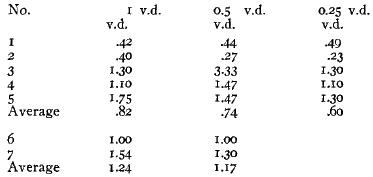
The first five observers had more than fifty percent of right judgments at 0.25 v.d.; hence the threshold is calculated for the three increments of the other cases. Number 6 got only 49 and number 7 only 46 per cent, right cases on the 0.25 increment. But the significant fact is that for both of these persons the number of right judgments on 0.5 v.d. was such as to give practically the same threshold as was found on 1.0 v.d. Only one important inconsistency occurs in the above table. In the case of No. 3. the right judgments at 0.5 give a threshold of 3.33 v.d. while at 1 v.d. and 0.25 v.d. the threshold is exactly the same.
Examination of the table therefore proves that in the region of the average physiological limit the conventional threshold may be computed on the basis of observations considerably below that limit (here in five cases out of seven) and that the actual physiological limit is always considerably below the conventional threshold. This is, of course, analogous to what we find in sight; under exceptionally favorable circumstances we may see a small, well defined object at a distance which, from the nature of the dioptric system, represents the physiological limit of acuity in vision but average records of acuity would ordinarily designate a point short of that distance.
From the standpoint of musical training it is important to know how the ability to distinguish differences of pitch is correlated with other mental characters, as general intelligence and singing ability. In addition to these we wish to know whether brothers and sisters are more closely correlated in ability to distinguish differences of pitch than other children not related. These questions are discussed in their order.
For the purpose of the correlation between pitch discrimination and general intelligence and singing ability, the data for pitch discrimination were obtained from the final days of the practice series. No single absolute measure of general intelligence is possible. For the present purpose the teachers were instructed to mark general intelligence on the basis of two criteria, brightness and reliability, assuming these to be of equal weight. By brightness is meant quickness and accuracy of mental grasp, or, in other words, general wide-awakeness, Reliability is self-explanatory. It is the correlate of a small mean variation for daily work. For convenience of marking, these two factors may be considered as having equal weight and may, therefore, be marked independently on a scale of 10. It was explained that the markings should follow approximately the normal distribution for each age and for both sexes. The mean of the two marks was taken as the mark representative of intelligence.
In order to facilitate correlation the ten units in the series of increments used in pitch discrimination were translated into corresponding values on the scale of 10, thus: 30 v.d. corresponds to 1; 23 to 2; 17 to 3; etc 0.5 v.d. to 10.
The markings on singing ability were also based on the teacher's judgment of the pupil's ability to sing correctly in pitch scale and a melody.
As regards kinship, three correlations were as follows: (1) between younger and older brothers and sisters with practice; (2) the same without practice; and (3) between the younger members of the second correlation and other children of the same age and sex as the second members, but not related.
The correlations were determined by the Pearson product-moments method. In order to show the relative distribution of individuals for each factor correlated, each group is subdivided into five grades. This is not a quintile subdivision as there is no attempt to have an equal number of persons in each subdivision. The distribution by grades serves the purpose of comparison quite as well as the quintile or quartile method and avoids the necessity of ranking, which is practically impossible on a scale of io units. The method of subdivision is very simple. The scale of 10 units is is divided into five equal parts. 1 and 2 = E. 3 and 4 = D. 5 and 6 = C. 7 and 8 = B. 9 and 10 = A. An example will make clear the method. An observer gets 3 in pitch discrimination and 7 in general intelligence. He belongs to Grade D in the first factor and in Grade B in the second factor. The number who are in the same grade in each factor indicates the degree of correlation. The number who are in different grades in the two factors indicates lack of correlation or low correlation.
The results show a relatively high coefficient of correlation between pitch discrimination and general intelligence, singing ability and musical training (Tables XIV and XV). It is higher for boys than for girls and highest for both boys and girls between pitch discrimination and general intelligence.
TABLE XIV.
Correlation of pitch discrimination with general intelligence and singing
ability.

TABLE XV.
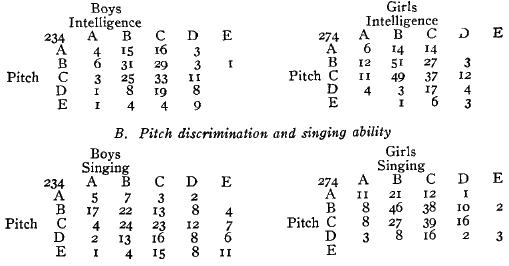
The fact of a high correlation between pitch discrimination and general intelligence favors the conclusion reached above that pitch discrimination depends partly upon the ability to learn, i,e, upon brightness and reliability. If this is a correct view, training in pitch discrimination is essentially mental training. It is more than reproducing tones; it is thinking tones. Another conclusion which is in harmony with what has just been said is that a child may possess a perfect ear for tones, and still be unable to distinguish differences in pitch. Musical training should begin with training in tone quality.
The coefficient of correlation between pitch discrimination and singing ability is technically high. A high correlation between these factors means that the ability to distinguish differences in the pitch of tones is an essential factor in learning to sing.
Table XVI shows that, for the groups compared, girls are superior to boys in pitch discrimination, since there are no girls in Grade B and relatively few in Grade D. But they are not shown to be essentially superior in singing ability.
TABLE XVI.
Correlations for blood relationship.

The coefficient of correlation between brothers and sisters on the basis of ability in pitch discrimination is not higher than between other children. This is true both for records without practice and records after practice. Although the results are clearly negative, no sweeping conclusion should be drawn because several variables are involved, such as advantage of the knowledge which comes with age, differences in intelligence, the element of competition, etc. This is regrettable since it had been definitely hoped and planned that this large collection of data might contribute to the solution of this interesting question. Finally, the younger member of each pair in the second correlation was compared with another child of the same age and sex as the second member, but not related, The coefficient of correlation is practically the same for the three groups. (Table XVII). No conclusions can be drawn from these meager results as regards the influence of heredity on tonal hearing.
TABLE XVII.
Correlation of pitch discrimination for younger and older brothers and sisters.
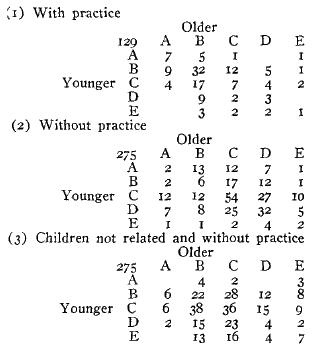
The quantitative statement and analysis of data has been presented in such condensed form that a summary of conclusions from that point of view is scarcely necessary. There is, however, need of a statement of "general conclusions" from the point of view of interpretation and application of the experimental results in the light of the quantitative data, the introspections of the observer, the daily notes of the experimenter, and a general study of the problem with the collaborators in research. Such a statement necessarily involves something of a personal equation and I am glad to acknowledge in this the cooperation of Professor Seashore whose long and varied experience in this field of research makes this interpretation possible.
The psychological limit in pitch discrimination is always below the conventional threshold (75 per cent, right cases). Thus, a person whose threshold is 1 v.d. may, under extraordinarily favorable circumstances, hear as small a difference as .25 v.d.; and it is probable that in the normal unreflective and uncritical appreciation of music the automatic "impression" of tone differences comes freely through this region of increments which are below the conventional threshold. This conventional threshold which can not be further reduced by instruction or training we have called the "approximate" physiological threshold. This is the concept of threshold that must be employed for most purposes of research and in nearly all applications of the test for practical purposes. The three factors which differentiate it from the true physiological threshold are-- the convention of counting 75 per cent, right cases, the physical variation in the organ of Corti, and the failure to keep all the conditions of the measurements under control.
Success in making a true measurement on an unexperienced observer in a single sitting varies with the knowledge, keenness, and care of the observer and the many objectively favorable or unfavorable conditions of the test as well as the experimenter; but, everything taken into account, it is safe to say that when an individual test is made under favorable conditions the approximate physiological threshold may be reached in a single sitting of less than an hour for more than half of the cases of adults or children who are bright and old enough to understand the test. Even in group tests by the heterogeneous method one may reach in an hour the approximate physiological threshold of nearly half of the observers who are old enough and bright enough to observe.
A cognitive threshold, always above the approximate physiological threshold, may be due to failure in understanding what is required in the test, lack of information, defect in auditory imagery and memory, lack of application, confusions, objective or subjective disturbances, expectations, inhibitions in writing or speaking, etc. Most of these conditions are such that they may be removed by information, by inducement to use the best effort, or by learning through some experience.
There are means of determining when the approximate physiological threshold has been reached. Chief among these are the mean variation and the character of the distribution of the errors. But in individual tests many direct observations on the character of the difficulties in judging may be helpful. In general, where a record is low (good) the chances are that the observer has no "cognitive" difficulties. The uncertainty is, of course, always with reference to the poor record. Practical advice or recommendation should therefore be cautious in the case of poor records for fear that the limit reached, although persistent, may be merely cognitive. One can not err on the side of getting too good a record; the danger is always that something has prevented a fair test of actual ability.
The sensitiveness of the ear to pitch difference can not be improved appreciably by practice. There is no evidence of any improvement in sensitiveness to pitch as a result of practice. When a person shows a cognitive threshold practice ordinarily results in a clearing up of the difficulties which in the way of a true measure of discrimination by information, observations, and the development of interest, isolation of the problem in hand, and more consistent application to the task in hand. This is, of course, not improvement in the psychophysic ear but merely a preliminary to a fair determination of the psychophysic limit. It follows that instruction in regard to the nature of the test and individual help are all important for the lowering of the cognitive limit and that mere practice for this purpose is a poor and uncertain makeshift. It also follows that a "cognitive" threshold is no measure at all but rather a confession that the measurement has not yet been successfully made.
Training in pitch discrimination is not like the acquisition of skill, as in learning to read or to hear overtones. It is in the last analysis informational and the improvement is immediate in proportion to the effectiveness of the instruction or the ingenuity of the observer and the experimenter in isolating the difficulty.
Reduced to its lowest terms the question of variation with age may be interpreted to mean that we have no evidence of improvement in the psychological limit of pitch discrimination with age; a young child of school age and even younger, can hear pitch fully as keenly as an adult. The amount in favor of the adult shown in all group statistics is amply accounted for by the difficulty in making a reliable test on the young and by their lack of information. This statement is based primarily on two lines of evidence-- the common occurrence of fine, irreducible records among young children, and the character of the conditions which are ordinarily overcome by instruction and training.
Pitch discrimination does not vary with sex to any significant extent. In the records here reported and in the many hundreds of other records in this laboratory in which comparisons may be made for sex, certain tendencies are shown in groups of records, sometimes in favor of one sex and other times in favor of the other sex, but on the whole, it seems certain that such differences, except so far as they are due to grouping, may be accounted for as due to the conditions of the test rather than to the sex difference in the psychophysic capacity of pitch discrimination. Thus one of the most consistent and striking differences reported above, that of the superiority of elementary schoolgirls over elementary schoolboys may probably be fully accounted for by the prevailing trait of aloofness of the preadolescent boy toward music. These boys often regard music as a sort of frill for girls and, therefore, enter the test with less fervor than do the girls. Such interpretation is supported in part by the fact that in the high school and in the university, where the girls have had far more advantage of training than the boys, the records reveal no appreciable difference for sex.
Not a single case of tonal deafness was isolated in any of the records here reported. This would indicate that if tonal deafness exists at all in a "normal" ear, it is no so common as has usually been supposed.
We have found a high correlation between pitch discrimination and, ability in singing, as judged by teachers. In the collective records there is also a high correlation between pitch discrimination and "general intelligence." This is undoubtedly due to the presence of so many "cognitive" as opposed to physiological thresholds.
Under the conditions of this test the records of members of the same family do not correlate more closely than do members of different families.
This test is elemental, i.e., when applied under favorable conditions it calls forth a relatively simple and immediate sensory discrimination which does not improve appreciably with practice. It is like the minimum visible angle in visual space-- the limit is set by the sense organ. We say "under favorable conditions" because the cognitive factors which condition a fair test must be recognized. As has been seen in a large percent of cases, we can get only a cognitive threshold in the first attempts. As elemental, this test is contrasted with, e.g., a test of ability to isolate overtones in a violin tone which represents a skill that can only be acquired through practice. It must be recognized that the test is a true and successful test, the results of which may be applied with safety, only as it is actually elemental.
The basal character of pitch discrimination in the appreciation and expression of music has become evident in many ways. Keen recognition of pitch difference is a condition of auditory imagery, auditory memory, singing or playing in true pitch. This is true as well for the affective attitudes with reference both to pitch and to timbre, for timbre is in the last analysis simply a pitch complex. It would therefore seem to be most fundamental of all tests of musical talent, although, of course, no one test by itself can be considered an adequate measure of such talent.
The educational value of this test has been strongly impressed during this work. It is unquestionably the isolation and measuring of one specific, basal factor in musical talent. It may be undertaken individually or in groups and commends itself particularly as one of the tests that should be made in schools for the purpose of vocational guidance in music, in the music studio for the purpose of learning where to place the emphasis in instruction and in adapting the course to the natural capacities of the student, and as a recurrent exercise in the schools and in the studio for the purpose of developing keenness in attention to detail of tone in ear training.
The instruments, i.e., the tuning forks and resonators as here used, and the method, both the heterogeneous and the homogeneous procedure, have proved eminently satisfactory.
1. The writer wishes to acknowledge his manifold indebtedness to Professor Seashore for his supervision and cooperation, which have made this research possible. To Dr. Mabel C. Williams and to companions in research who are working upon related problems in the laboratory, he expresses his grateful appreciation for assistance. [Return to text]
2. The term is here used in the sense defined by Seashore (3) page 49-50. "The Cognitive vs. the Physiological Threshold. In sensory discrimination of this sort we may speak of two thresholds: the physiological, which is set by the limits of capacity in the end organ; and the cognitive, which is set by cognitive limitations. Theoretically we always aim to reach the physiological threshold, but practically we often fall short of this and find a cognitive limit; i.e., a higher threshold due to lack of information, best form of attention, interest, effort, etc.; or to disturbances of some sort. Usually inspection of a record or observations made in the test enable us to tell whether or not we have reached the physiological threshold. It cannot be judged by a single rule, although a small m.v. and a well defined mode are pretty sure indications. This distinction is of greatest importance in classification, and in the theory of training." [Return to text]